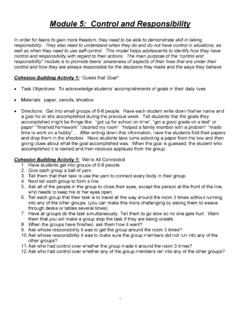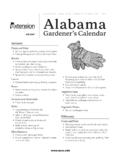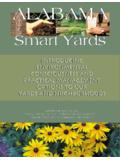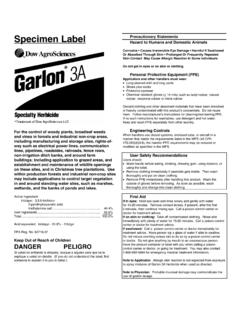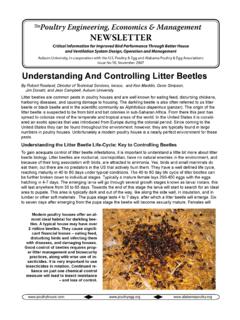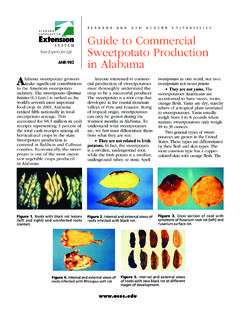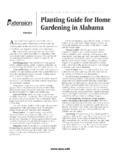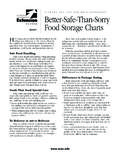Transcription of Module 1: Communication - ACES.edu
1 Module 1: Communication The use of effective Communication skills is an important social competency. This Module assists adolescents with distinguishing between aggressive, assertive and nonassertive Communication . Adolescents have opportunities to experience using these three types of Communication , and to gain an understanding of how assertive Communication will assist them in their daily lives. This Module serves as a foundation for subsequent modules that will require effective Communication skills. Cohesion Building Activity 1: Group Juggling Task Objectives: Cooperation, problem solving, and listening skills Materials: 4-6 balls per group (use small balls that are made of a range of soft materials such as nerf, rubber, Styrofoam, and cloth).
2 Directions: This activity is best when done with a large group. Facilitator begins by explaining the task to the group. There are only two things you have to remember to play this game remember who throws the ball to you and to whom you throw the ball. Before throwing the ball to the person, you need to call out his or her name. We are going to toss this ball around the group until everyone has gotten it once. The facilitator will call out a student's name and toss the ball to him or her. The student then tosses the ball to another student after saying his or her name. This continues until the ball has reached everyone and has returned to the facilitator's hands.
3 Repeat the sequence several times, the last time through, note how many seconds it took to get the ball tossed around the group and report that time to the group ( , that took us 45. seconds ). Ask the students: How we can make the ball progress through the group in the quickest way possible? (ideas: get the group closer together, stand next to the people you get the ball from and give it to). See how much the group improves its time. Process Questions: What did we have to do to get the ball around as fast as possible? How did you feel when we improved our time? Are their times in your life when you have to solve problems in creative ways?
4 How does it help to get assistance from other people for some of the tougher problems you face? [feel free to add other process questions]. Finally, have students get back into a large circle and find the place they were standing when we first started the game. Tell them we are going to pass the ball around like we did the first time. The facilitator starts the first ball and after several seconds starts a second ball, then a third ball, then a fourth ball. Finally, when all of the balls have progressed through the group once or twice, and have returned to the facilitator, the facilitator asks the final Process Questions: How did you manage to handle all of the balls being tossed to you?
5 What happened if you had a ball tossed to you before you were ready for it? What did you do if you noticed that the person you were tossing the balls to was not ready for the next one? In real life, some times we have a lot of things to deal with, and we have to work extra hard to manage everything - like we did when we were trying to juggle all of these balls. When this happens, it can help to slow down a little so we can figure out how to manage the different things that are flying at us. What do you do to manage things when you have a lot to handle? . 1. CENTRAL ACTIVITY: Communication Role Plays Task Objectives: Understanding and using verbal and nonverbal Communication ; listening skills.
6 Materials: role play descriptions; signs containing the words assertive, nonassertive aggressive . Directions: Prior to activity, facilitators memorize definitions of nonassertive, assertive, and aggressive Communication (use note cards if needed). At the beginning of the session hand each student a set of Communication cards (see page At the start of the activity, facilitators present students with examples of each style of Communication . Nonassertive: Act out the following scene demonstrating nonassertive Communication . Prior to the role play, tell the students to watch the facilitator ( , focal teen ) that will be communicating nonassertively (but do not tell them how the person will communicate).)
7 The other two teens should be persistent by not overly aggressive in their Communication . Two teens are pestering a third teen to let them cheat off her test during an exam. The student does not want to let them cheat but responds nonassertively to the other two teens'. demands to let them cheat. After the role play, ask the students how the focal teen was communicating. They may not use the word nonassertive, but may say things like she did not stand up for herself she let the other people push her around. Tell the students that they are correct and then tell them that this kind of Communication is called Nonassertive Communication .
8 Hold up one of the signs that contain the word Nonassertive. Then tell the students the definition of nonassertive Communication : Nonassertive: avoiding saying what you think, feel, want, or believe You are afraid to risk the consequences You don't believe in your own rights You don't know how to speak up for yourself You think another person's rights are more important than yours Aggressive: Act out the following scene demonstrating aggressive Communication . Prior to the role play, remind the students to watch the facilitator ( , focal teen ) that will be communicating aggressively (but do not tell them how the person will communicate).
9 Two teens are pestering a third teen to let them cheat off her test during an exam. The student does not want to let them cheat but responds aggressively to the other two teens'. 2. requests to let them cheat. The other two teens become aggressive in response to the focal teen's aggressiveness. After the role play, ask the students how the focal teen was communicating. They may not use the word aggressive, but may say things like she was in their face she was putting them down. Tell the students that they are correct and then tell them that this kind of Communication is called Aggressive Communication . Hold up one of the signs that contain the word Aggressive.
10 Then tell the students the definition of aggressive Communication : Aggressive: saying what you think, feel, want, or believe in ways that deny another person's right to be treated with respect (anger, meanness, hurtfulness, put-downs, spitefulness, etc). Assertive: Act out the following scene demonstrating assertive Communication . Prior to the role play, remind the students to watch the facilitator ( , focal teen ) that will be communicating assertively (but do not tell them how the person will communicate). Two teens are pestering a third teen to let them cheat off her test during an exam. The student does not want to let them cheat and responds assertively to the other two teens'.
